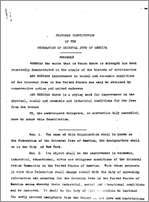During the last decades of the nineteenth century, individual Ottoman Jews began to make their way to the United States in search of economic opportunity. Among them were merchants who sold their wares at the world's fairs held in Philadelphia, Chicago, and St. Louis in 1876, 1893, and 1904, respectively, only to remain in the country and try their luck at earning a living in the New World. By the first decade of the twentieth century, the numbers of Jews entering the United States from Ottoman lands skyrocketed. The new waves of emigration were propelled by a number of factors, including a new universal military conscription law announced by the Ottoman government following the "Young Turk" revolution of 1908, the expulsion of Italian Jewish subjects long resident in the empire during the Italian-Ottoman War of 1911, the Balkan Wars of 1912-1913, compulsory military conscription in Greece in 1916, and a massive fire that devastated the historic Jewish quarter of Salonica in 1917.
These and various other factors, including the continued search for economic betterment as well as political freedoms
By this time, Jews of Ottoman origin had formed communities in various cities across the United States, including Seattle, Los Angeles, Cincinnati, Atlanta, Chicago, and Philadelphia, although the greater New York area remained the epicenter of the new Ottoman Jewish émigré populations. These communities settled in particular districts and established various religious institutions and places of leisure of their own, often organizing themselves according to their cities of origin in the Old World. At the same time, a Ladino newspaper, La Amerika, offered the new Judeo- Spanish-speaking immigrants among them a shared, virtual community by 1910.
Within a year, a number of self-appointed leaders of these new Jewish immigrant groups joined forces with communal elites from the established Jewish communities of New York to create an organization they hoped would attend to the particular needs of the Greek-, Arabic-, and Ladino-speaking Jews who had recently arrived in the United States from the Ottoman Empire and its successor states in southeastern Europe. Although the organization was founded as "The Federation of the Oriental Jews of America" in 1912, the founders had drafted a proposed constitution for their fledgling organization already in 1911: an original typescript copy of this document forms part of the Arnold and Deanne Kaplan Collection of Early American Judaica at the Library at the Katz Center in Philadelphia. In this text, we get a glimpse of the concerns of the organization's founders, who sought to accelerate the assimilation of the recent Levantine Jewish immigrants to the United States by offering night classes in English, while also discouraging any political debates that might alienate the new immigrants from one another, or from their new government.
